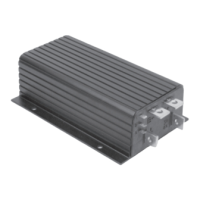26
Curtis PMC 1204/1205 Manual
Hot Controller
If the controller gets hot, it does not necessarily indicate a serious problem.
Curtis PMC 1204/1205 controllers protect themselves by reducing power
to the motor if their internal temperature exceeds 75°C (167°F). Power
output will be reduced for as long as the overheat condition remains, and
full power will return when the unit cools.
In typical applications, overheating will rarely be a problem. How-
ever, operation with oversized motors and vehicle overloading may cause
overheating, particularly if the controller is mounted so that heat cannot
be conducted away from its case or if other heat-generating devices are
nearby. If thermal cutback occurs often during normal operation, the
controller is probably undersized and should be replaced with a higher
current model.
Unintended Activation of HPD
Sudden applications of full throttle may activate the HPD feature, in
applications where the pedal microswitch is wired in line with KSI. This
happens if the pot is rotated well into its active stroke before the microswitch
can cause the controller to power up. Normal nonabusive application of
the throttle should not cause this action.
IN-VEHICLE DIAGNOSTIC TESTS
These tests require a general purpose volt ohmmeter; you can use either
a conventional “V-O-M” or an inexpensive digital voltmeter.
The troubleshooting chart (opposite) serves as a guide to the proce-
dures that follow. Before starting these tests, refer to the appropriate
wiring diagrams and make sure your controller is hooked up properly.
TROUBLESHOOTING & BENCH TESTING
☞
Working on electric vehicles is potentially dangerous. You should
protect yourself while performing the diagnostic tests by jacking up
the vehicle to get the drive wheels off the ground, opening the battery
circuit before working on the motor control circuit, wearing safety
glasses, and using properly insulated tools (see page 2).
CAUTION

